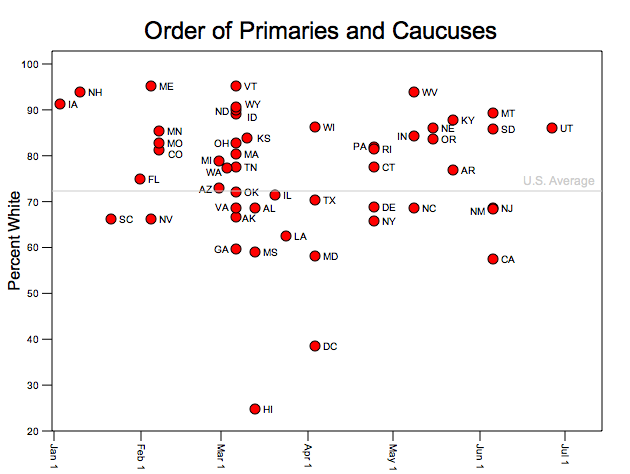Letting White Voters Choose the Nominee
Iowa and New Hampshire jealously hoard the front of the primary calendar. This year is a perfect example why. After basically tying in the first state and winning the second, Mitt Romney appears to have the Republican nomination in a lock. And that's ignoring the cash it brings. In Iowa alone, candidates spent $12.5 million on television advertising and traveled more than 23,000 miles.
These two states also happen to be among the most monochrome in the nation, at 91.3 and 93.9 percent white, respectively, while the U.S. average is 72.4. Since the campaign moved to South Carolina, racially themed questions and complications for the candidates have multiplied, which got us wondering exactly how front-loaded the calendar is with heavily white states like the first two. Consider the following simple scatter plot, which shows the date of the primary on the x-axis and the white percentage of the population on the y-axis:
Source: U.S. 2010 Census
Of the first nine contests, only South Carolina and Nevada have a white population below the national average. And that's affording states after New Hampshire a more-than-generous role in determining the nominee. (Note: These figures, all from the 2010 census, include people who identify themselves as white and Hispanic. If you subtract them, Iowa and New Hampshire fall to 88.7 and 92.3 percent white, respectively, compared to a national percentage of 63.7.)
Every year's primary is different, but we can all agree that the first two contests set the tone for every subsequent one, even if the battle is still unresolved after January. There's no better evidence than in Romney's prospects for Saturday. Three weeks ago, he had about even odds to win the primary in South Carolina. He is now all but a shoo-in.
It would be commentary worthy of cable television to suggest the racial makeup of a state is the only factor of real importance in an election, particularly in a contest like this one when no one candidate has a clear advantage among people of any particular background. The fact remains that, in 2012, very few non-whites participated in a meaningful caucus or primary. A party hoping to make headway with minority voters may want to consider this before re-awarding the top spots to two of the five whitest states in America.

